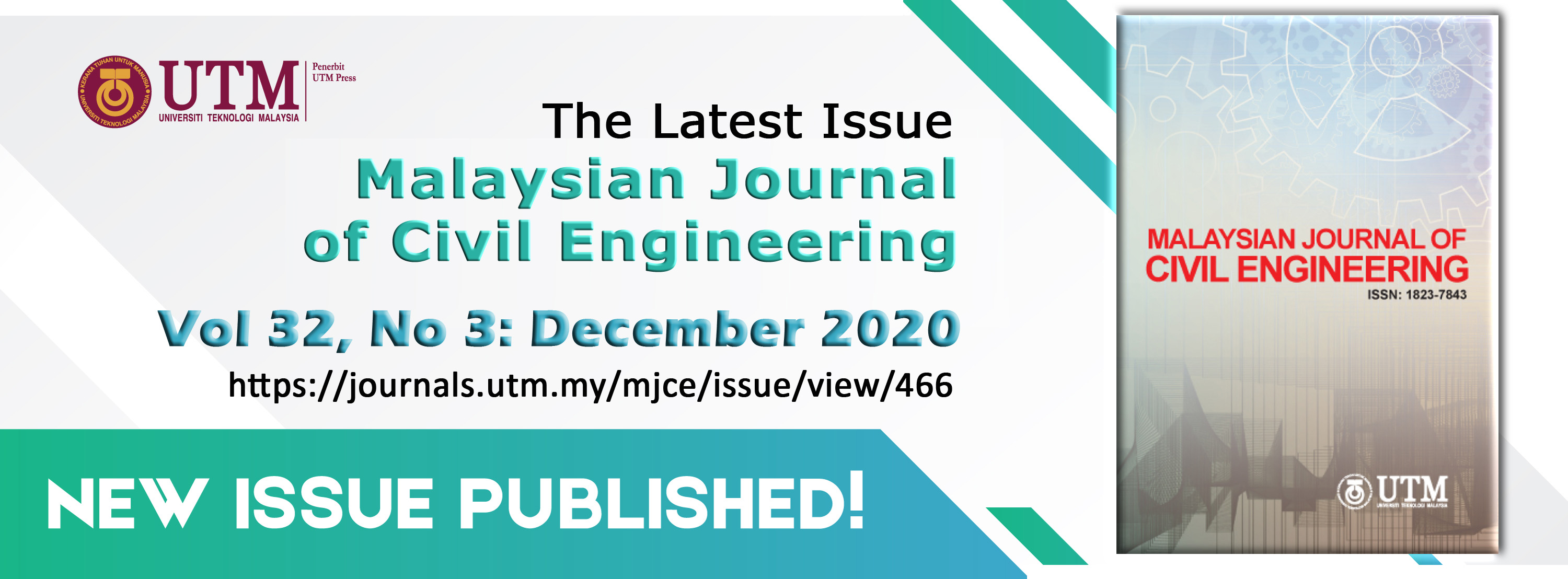SOME PROPERTIES OF PHOSPHORIC ACID STABILISED LATERIZED ADOBE BRICKS
DOI:
https://doi.org/10.11113/mjce.v32.16240Keywords:
Residual tropical laterite, Phosphoric acid, pH, Compressive strength, Southwestern Nigeria, Adobe bricks.Abstract
The changes in the compressive strength of laterized bricks produced from stabilised residual tropical laterite (RTL) are reported in this paper. The RTL was stabilised with different percentages (2, 4, 6 and 8%) by weight of dry soil of 1M phosphoric acid (PA). Some geotechnical properties and elemental oxide composition of the RTL were determined. Adobe bricks were produced from the PA stabilised, 5% cement stabilised and unstabilised RTL. Adobe bricks produced from 5% cement stabilised RTL served as the control. The bricks were cured under ambient air condition for 7, 14, 21 and 28 days. The pH, dry density, moisture content and compressive strength (fc) of the bricks were determined at the end of each curing period. The influence of PA was evaluated using the changes in the fc of the adobe bricks. The effectiveness of PA was also evaluated using a standard minimum requirement. Statistical analysis of the results was done using Analysis of variance. There was about 90 and 200% increase in fc of PA and cement stabilised Adobe bricks, respectively. The fc of 6% PA stabilised and cement stabilised adobe bricks met the minimum requirement. It is concluded that PA has great potential for stabilising Adobe bricks for building.
References
Sahu MK, and Singh L (2017) Critical Review on Types of Bricks Type 4: Adobe Bricks. Int. J. Mech. Prod. Eng., 11, 116–119.
Houben H, and Guillaud H (1994). Earth construction; International, comprehensive guide., 1st editio. London UK: ITDG Publishing.
Smith EW, Puebio SJ (1981). Adobe brick production in New Mexico. New mexico bureau of mines and mineral resources, 3(2), 17-24.
Bahobail M A. (2012) The Mud Additives and their Effect on Thermal Conductivity of Adobe Bricks. J. Eng. Sci., 40(1): 21-34. Corpus ID: 106398666
Benghida D (2015). Adobe Bricks: The Best Eco-Friendly Building Material. Advance Materials. Res. 1105 (May 2015): 386–390. https://doi.org/10.4028/www.scientific.net/AMR.1105.386
Begum R, Habib A, Begum HA (2014). Adobe Bricks Stabilized With Cement and Natural Rubber Latex. Int. J. Emerg. Sci. Eng., 2(4): 36–38.
Oyediran IA, Ayeni OO (2020). Comparative effect of microbial induced calcite precipitate, cement and rice husk ash on the geotechnical properties of soils. SN Applied Sciences https://doi.org/10.1007/s42452-020-2956-0
Neville AM (2011). Properties of Concrete (Fifth Edit). Edinburgh Gate Harlow Essex CM20 2JE England: Pearson Education Limited.
Chen C, Habert G, Bouzidi Y, Jullien A (2010). Environmental inpact of cement production: detail of the different processe and cement plant variability evaluation. Journal of cleaner production, 18(5): 478-485.
https://doi.org/10.1016/j.jclepro.2009.12.014
Olofinyo OO, Olabode OF, Fatoyinbo IO (2019). Engineering properties of residual soils in part of Southwesten Nigeria: Implication for road foundation. SN Applied Sciences https://doi.org/10.1007/s42452-019-0515-3
Ayodele AL, Oketope OM, Olatunde OS (2019). Effects of Sawdust Ash and Eggshell Ash on Selected Engineering Properties of Lateralized Bricks for Low Cost Housing. Niger. J. Technol, 38(2): 278–282. DOI: 10.4314/njt.v38i2.1
Olajumoke AM, Olonade KA, Obaye UJ, Ishola OO (2011). A Study of Some Engineering Properties of Coconut Shells Ash Stabilised Lateritic Bricks for Affordable Housing. Proceeding Fac. Technol. Conf. Innov. Technoogies Socio-economic Transform. Dev. Countries. Ile-Ife, Niger., 89–95.
Lyons JW, McEwan GJ (1961). Use of phosphoric acid in soil stabilization. Highw. Res. Board Bull., 282: 4–14.
Bell FG (1993). Engineering treatment of soils, in Engineering Treatment of Soils, First edit., The Promotion Department, E & FN Spon, London SE1 8HN: E & FN Spon, 259.
Eisazadeh A, Kassim KA, Nur H (2011). Characterization of phosphoric acid- and lime-stabilized tropical lateritic clay, Environ. Earth Sci., 63 (5): 1057–1066. https://doi.org/10.1007/s12665-010-0781-2
Ayodele AL, Agbede OA (2017). Influence of Electrochemical Treatment on a Typical Laterite, Ground. Improv, 171(2): 1–9. http://doi.org/10.1680/jgrim.16.00030
Ayodele A L, Pamukcu S, Shrestha A R, Agbede O A. Electrochemical Soil Stabilization and Verification, Geotech. Geol. Eng., 2018, 36(2): 1283-1293. https://doi.org/10.1007/s10706-017-0392-8
Medina J, and Guida HN (1995). Stabilization of Lateritic Soils with Phosphoric Acid. Geotech. Geol. Eng., 13:199–216. https://doi.org/10.1007/BF00422210
Nigerian Brick and Road Research Institute, (NBRRI) (2010). Interlocking Blockmaking Machine. NBRRI Newsletter, 1(1), 15 – 17.
Das BM (2002). Soil Mechanics Laboratory Manual, 6th Ed. California: New York Oxford University Press.
Alabo EH, Pandy P (1987). Distribution of Engineering Properties of Red Soils in the Central Lower Niger Delta, Nigeria. Proceeding 9th African Reg. Conf. Soil Mech. Found. Eng. Lagos, 49–55.
Gidigasu MD (1976). Laterite Soil Engineering: Pedogenesis and Engineering Principles, Elsevier Sci. Publ. Company, Amsterdam., pp. 150.
Das B M (2006). Principles of Geotechnical Engineering, Seventh., Cengage Learning, p. 104.
Potash and potash institute, Phosphorus mobility in perspective. https://www.nrcs.usda.gov/Internet/FSE_DOCUMENTS/nrcs142p2_053254.pdf
Clifton JR, Davis FL (1979). Mechanical Properties of Adobe, Washington, D.C. 20234.
Salim RW, Ndambuki JM, Adedokun DA (2014). Improving the bearing strength of sandy loam soil compressed earth block bricks using Sugercane Bagasse Ash, Sustain., 6(6): 3686–3696.
















